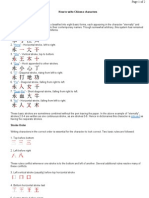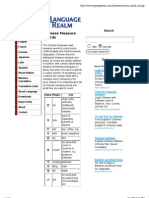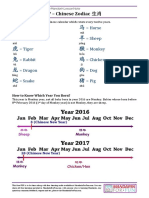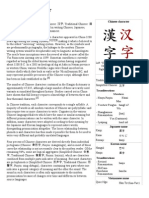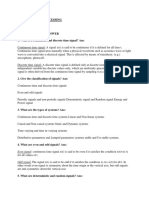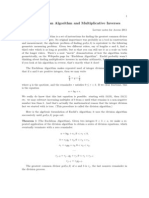Strokes Order of Chinese Characters
Strokes Order of Chinese Characters
Uploaded by
BittlemanCopyright:
Available Formats
Strokes Order of Chinese Characters
Strokes Order of Chinese Characters
Uploaded by
BittlemanOriginal Description:
Original Title
Copyright
Available Formats
Share this document
Did you find this document useful?
Is this content inappropriate?
Copyright:
Available Formats
Strokes Order of Chinese Characters
Strokes Order of Chinese Characters
Uploaded by
BittlemanCopyright:
Available Formats
KI 1020
Stroke order of Chinese characters
All Chinese characters consist of strokes which should be written in a specific order. Learning the stroke order is an important part of learning to write Chinese characters. At first you may need help from a teacher, book, or other learning aid to determine the stroke order for characters you encounter. The more characters you become familiar with, the easier it becomes to see which principle applies to a given character. In short, learning these following nine principles of stroke order will ultimately save you from having to memorize rules character by character.
1. Write from top to bottom, and left to right.
As a general rule, strokes are written from top to bottom, and left to right. For example, among the first characters usually learned is the number one, which is written with a single horizontal line: . This character has one stroke which is written from left to right. The character for "two" has two strokes: . In this case, both are written from left to right, but the top stroke is written first. The character for "three" has three strokes: . Each stroke is written from left to right, starting with the uppermost stroke. This rule also applies to the order of components. For example, can be divided into two. The entire left side () is written before the right side (). There are some exceptions to this rule, mainly occurring when the right side of a character has a lower enclosure (see below). When there are upper and lower components, the upper components are written first, then the lower components, as in and . 2. Horizontal before vertical
KI 1020
When horizontal and vertical strokes cross, horizontal strokes are usually written before vertical strokes: the character for "ten," , has two strokes. The horizontal stroke is written first, followed by the vertical stroke . 3. Character-spanning strokes last
Vertical strokes that pass through many other strokes are written after the strokes through which they pass, as in and . Horizontal strokes that pass through many other strokes are written last, as in and . 4. Diagonals right-to-left before diagonals left-to-right
Right-to-left diagonals (, pi) are written before left-to-right diagonals (, n): . Note that this is for symmetric diagonals; for asymmetric diagonals, as in , the leftto-right may precede the right-to-left, based on other rules.
5. Center before outside in vertically symmetrical characters
In vertically symmetrical characters, the centre components are written before components on the left or right. Components on the left are written before components on the right, as in and . 6. Enclosures before contents
KI 1020
Outside enclosing components are written before inside components; bottom strokes of the enclosure are written last if present, as in and . Enclosures may also have no bottom stroke, as in and .
7. Left vertical before enclosing
Left vertical strokes are written before enclosing strokes. In the following two examples, the leftmost vertical stroke (|) is written first, followed by the uppermost and rightmost lines () (which are written as one stroke): and .
8. Bottom enclosures last
Bottom enclosing components are usually written last: , , , .
9. Dots and minor strokes last
Minor strokes are usually written last, as the small "dot" (dian) in the following: , , .
You might also like
- 50 Most Common Adjectives ChineseDocument8 pages50 Most Common Adjectives ChineseSheng Ying Liang100% (1)
- Chinese Vocabulary BodyDocument3 pagesChinese Vocabulary BodyWei LeeNo ratings yet
- Business Statistic PPB3063 Group Assignment Influence of Wifi Performance On Students SatisficationDocument31 pagesBusiness Statistic PPB3063 Group Assignment Influence of Wifi Performance On Students Satisficationain100% (1)
- Chinese Character Stroke OrderDocument2 pagesChinese Character Stroke Orderkhwanta-btaNo ratings yet
- CME 1000 Chinese CharactersDocument32 pagesCME 1000 Chinese CharactershangshabNo ratings yet
- Read New Practical Chinese Reader, Textbook Vol. 2 (English and Mandarin Chinese Edition) by Jerry SchmidtDocument2 pagesRead New Practical Chinese Reader, Textbook Vol. 2 (English and Mandarin Chinese Edition) by Jerry SchmidtLuciano RomualdoNo ratings yet
- Unit Plan Chinese III WeatherDocument3 pagesUnit Plan Chinese III Weatherapi-250349986100% (1)
- Word Order - Chinese Grammar WikiDocument6 pagesWord Order - Chinese Grammar Wikicaspersoong100% (2)
- 2 1characterDocument11 pages2 1characterellen8liuNo ratings yet
- Pinyin: 1 History of Romanization of Chi-Nese Characters Before 1949Document16 pagesPinyin: 1 History of Romanization of Chi-Nese Characters Before 1949Carlos EdreiraNo ratings yet
- Chinese Calligraphy ClassDocument26 pagesChinese Calligraphy ClassLanaNo ratings yet
- Question Bank No 1. For First MCQDocument22 pagesQuestion Bank No 1. For First MCQUnknown Laapta81% (16)
- Building AcousticsDocument270 pagesBuilding AcousticsAnonymous IGtWHoi0100% (4)
- Basic Rules of Stroke OrderDocument3 pagesBasic Rules of Stroke OrderJG EusebioNo ratings yet
- BLHL 1212 Bahasa Mandarin: Tan Poh EeDocument23 pagesBLHL 1212 Bahasa Mandarin: Tan Poh Eeasyiqin100% (1)
- 8-Week Instensive Mandarin Program NSYSU (Normal)Document10 pages8-Week Instensive Mandarin Program NSYSU (Normal)Lucien LeeNo ratings yet
- Tsinghua Chinese: Start Talking With 1.3 Billion PeopleDocument54 pagesTsinghua Chinese: Start Talking With 1.3 Billion PeopleAli Hoai Tin Do0% (1)
- List of Chinese ClassifiersDocument14 pagesList of Chinese Classifiershartmann10No ratings yet
- 拼音Document28 pages拼音黄小勇No ratings yet
- Chinese Measure WordsDocument4 pagesChinese Measure Wordsvicky20jak100% (1)
- Introduction To Chinese LanguagesDocument42 pagesIntroduction To Chinese LanguagesSim Tze Wei100% (1)
- Mastering The Basic ChineseDocument4 pagesMastering The Basic ChineseMohamed Mouha YoussoufNo ratings yet
- Chinese Vocabulary ListDocument137 pagesChinese Vocabulary Listnalu_angel979100% (2)
- Formation of Chinese Characters - Mandarin Chinese IDocument2 pagesFormation of Chinese Characters - Mandarin Chinese IEstela DuarteNo ratings yet
- Stories With Chinese CharactersDocument15 pagesStories With Chinese Charactersppalme100% (3)
- Guo'an, Wang - Learn To Speak Chinese - Book 1Document95 pagesGuo'an, Wang - Learn To Speak Chinese - Book 1Cycero Tavares100% (1)
- 中華函授華語教材 (B1) Chapter 1Document36 pages中華函授華語教材 (B1) Chapter 1Fuying LinNo ratings yet
- MandarinForFun - Level 1 Lesson 7Document2 pagesMandarinForFun - Level 1 Lesson 7MandarinForFunNo ratings yet
- Information Sheet: Online ChineseDocument11 pagesInformation Sheet: Online ChineseHC LawNo ratings yet
- CLASS ACTIVITIES - Level 2 PDFDocument4 pagesCLASS ACTIVITIES - Level 2 PDFHarold HernandezNo ratings yet
- Chinese Writing LessonDocument29 pagesChinese Writing Lessonsky90% (10)
- Stroke Order in ChineseDocument7 pagesStroke Order in Chineseprefect447449No ratings yet
- Kindergarten Lesson Plan 5Document5 pagesKindergarten Lesson Plan 5alyssamanningNo ratings yet
- As A Practice: Temporary CalligraphyDocument6 pagesAs A Practice: Temporary CalligraphyCatalinaDimaIonNo ratings yet
- CHI5001 Chinese-for-Engineers TH 1 AC41 PDFDocument2 pagesCHI5001 Chinese-for-Engineers TH 1 AC41 PDF;(No ratings yet
- Vocabulary of Lesson 1&2Document1 pageVocabulary of Lesson 1&2Florina PopaNo ratings yet
- Chinese CharacterDocument17 pagesChinese Characterberpop854433% (3)
- Happy Chinese 2011Document1 pageHappy Chinese 2011gsakir77No ratings yet
- Chinese - Yr 9 - Unit 1 - VELS Unit PlannerDocument8 pagesChinese - Yr 9 - Unit 1 - VELS Unit PlannerBendigo South East CollegeNo ratings yet
- Chinese CharactersDocument43 pagesChinese CharactersChristophvonStroheimNo ratings yet
- Learn Chinese With Yi Zhao - YouTube - YouTubeDocument73 pagesLearn Chinese With Yi Zhao - YouTube - YouTubeashkenadaharsaNo ratings yet
- Grammar Absolutely BeginnerDocument63 pagesGrammar Absolutely BeginnerSchirlomin WangNo ratings yet
- Hanzi Pinyin English: HSK Level 2Document5 pagesHanzi Pinyin English: HSK Level 2Anonymous 4txA8N8etNo ratings yet
- 100 Radicals Peter PDFDocument6 pages100 Radicals Peter PDFMOHD REHANNo ratings yet
- Shout Quality: To To ReturnDocument3 pagesShout Quality: To To ReturnPbNo ratings yet
- 《HSK标准教程1》课件 HSK1 L5Document40 pages《HSK标准教程1》课件 HSK1 L5王萌哲No ratings yet
- Mandarin Chinese Phonetics: - Third EditionDocument13 pagesMandarin Chinese Phonetics: - Third EditionJing Lee100% (1)
- MandarinForFun - Level 1 Lesson 6Document1 pageMandarinForFun - Level 1 Lesson 6MandarinForFunNo ratings yet
- Wu ChineseDocument24 pagesWu ChinesePlataforma ESGNo ratings yet
- Success With New HSK Level 6 Simulated Reading TestsDocument6 pagesSuccess With New HSK Level 6 Simulated Reading Testssweet niaNo ratings yet
- Integrated Chinese: Level 1 - Part 1Document44 pagesIntegrated Chinese: Level 1 - Part 1jeseljay15No ratings yet
- 5423 6c60Document2 pages5423 6c60Faizan Sheikh0% (1)
- Intermediate Chinese Character Course Design: Utilizing The Stories Behind Idiomatic Expressions As ContextDocument154 pagesIntermediate Chinese Character Course Design: Utilizing The Stories Behind Idiomatic Expressions As Context盧志No ratings yet
- Read Mandarin Chinese English Bilingual Visual Dictionary Free Ebooks For Kindle Free Download E1523846312233Document2 pagesRead Mandarin Chinese English Bilingual Visual Dictionary Free Ebooks For Kindle Free Download E1523846312233Chandan DasNo ratings yet
- All of The HSK 5 WordsDocument111 pagesAll of The HSK 5 Words박찬우No ratings yet
- Lesson 2 - Ni HaoDocument35 pagesLesson 2 - Ni Haoapi-301797151No ratings yet
- Basic Chinese CharactersDocument3 pagesBasic Chinese CharactersSanxin EINo ratings yet
- Introduction to Chinese Characters - 漢字介紹Document6 pagesIntroduction to Chinese Characters - 漢字介紹fuying884722No ratings yet
- Character Stroke Order Basic RulesDocument3 pagesCharacter Stroke Order Basic RulesadéjeunerNo ratings yet
- Các nét của chữ Hán và quy tắc bút thuậnDocument3 pagesCác nét của chữ Hán và quy tắc bút thuậnHàPhươngMaiNo ratings yet
- How To Write Chinese CharactersDocument12 pagesHow To Write Chinese CharactersAntonio Sanchez SanzNo ratings yet
- Stroke Order For Writing Chinese CharactersDocument7 pagesStroke Order For Writing Chinese Charactersjinlut6No ratings yet
- Measurements in Quantum MechanicsDocument360 pagesMeasurements in Quantum MechanicsBittleman100% (3)
- Plutonium A History of The Worlds Most Dangerous ElementDocument212 pagesPlutonium A History of The Worlds Most Dangerous ElementCláudio Proença Figueira100% (2)
- Measuring Firearm NoiseDocument5 pagesMeasuring Firearm NoiseBittlemanNo ratings yet
- 2012 and The End of The WorldDocument161 pages2012 and The End of The WorldBittlemanNo ratings yet
- Carl Gustav m45Document18 pagesCarl Gustav m45lobosolitariobe100% (2)
- Human Auditory Perception of Pulsed Radiofrequency EnergyDocument29 pagesHuman Auditory Perception of Pulsed Radiofrequency EnergyBittlemanNo ratings yet
- Ebook - The Private Weaponeer - Tracers N StuffDocument28 pagesEbook - The Private Weaponeer - Tracers N StuffBittlemanNo ratings yet
- Norm and Inner Products in C, and Abstract Inner Product Spaces Math 130 Linear AlgebraDocument2 pagesNorm and Inner Products in C, and Abstract Inner Product Spaces Math 130 Linear AlgebraEdwin LeónNo ratings yet
- R. G. D. Allen - Technical ProgressDocument28 pagesR. G. D. Allen - Technical ProgressArturo GuevaraNo ratings yet
- Effect of Impeller Blades Number On The Performance of A Centrifugal PumpDocument10 pagesEffect of Impeller Blades Number On The Performance of A Centrifugal PumpPrasad GharatNo ratings yet
- BSBPMG522 Student Assessment TasksDocument33 pagesBSBPMG522 Student Assessment TasksAshaNo ratings yet
- Effects of Geometry of A Local Thin Area Defect On Remaining Strength andDocument12 pagesEffects of Geometry of A Local Thin Area Defect On Remaining Strength andadityamunthe93No ratings yet
- 16-Secure Hash Algorithms (SHA) - 08!03!2024Document27 pages16-Secure Hash Algorithms (SHA) - 08!03!2024YashNo ratings yet
- Spread SpectrumDocument30 pagesSpread Spectrumalbin paul100% (1)
- DSP 2 MaarksDocument30 pagesDSP 2 MaarksThiagu RajivNo ratings yet
- Volume and Wetted Area of Partially Filled Vertical Vessels - Neutrium PDFDocument12 pagesVolume and Wetted Area of Partially Filled Vertical Vessels - Neutrium PDFdaimon_p100% (1)
- EuclidDocument5 pagesEuclidAruna Chandrashekhar SamantNo ratings yet
- Reel Cable PDFDocument2 pagesReel Cable PDFfitriansyah_emNo ratings yet
- Applied Math PHD DissertationDocument8 pagesApplied Math PHD DissertationCustomWrittenCollegePapersCanada100% (1)
- Geophysical Lab-VI Experiment No. 1Document4 pagesGeophysical Lab-VI Experiment No. 1Kartik SharmaNo ratings yet
- Structural Geology Chapter 8Document40 pagesStructural Geology Chapter 8Elijah IbsaNo ratings yet
- EXercise 2 Seismic Exploration - 1Document58 pagesEXercise 2 Seismic Exploration - 1FaisalNo ratings yet
- MATLAB Modeling of SPT and Grain Size Data in Producing Soil-ProfileDocument5 pagesMATLAB Modeling of SPT and Grain Size Data in Producing Soil-Profileicv.xaviNo ratings yet
- PID Theory Explained, Komplett PDFDocument5 pagesPID Theory Explained, Komplett PDFThierry BaudorreNo ratings yet
- Geometry Section 4.3 NotesDocument1 pageGeometry Section 4.3 NotesEricaNo ratings yet
- Lab Report Triffilliarc PDFDocument17 pagesLab Report Triffilliarc PDFsohail parachaNo ratings yet
- VEbookDocument428 pagesVEbookНина ПестушкоNo ratings yet
- Maths Y10 T1a Mid Term Break Pack 2024-2025Document5 pagesMaths Y10 T1a Mid Term Break Pack 2024-2025angeglory123No ratings yet
- Match Function: Questions Answered in This ChapterDocument8 pagesMatch Function: Questions Answered in This ChapterParesh AglaveNo ratings yet
- Fundamentals of Natural ComputingDocument14 pagesFundamentals of Natural Computingst00katzNo ratings yet
- Calculus Midterm Practice 2Document2 pagesCalculus Midterm Practice 2Lucas ZaccagniniNo ratings yet
- Verilog HDLDocument62 pagesVerilog HDLc406400100% (1)
- All Things Algebra GEOMETRY YouTube Video LinksDocument1 pageAll Things Algebra GEOMETRY YouTube Video Linksskylar.charlese2010No ratings yet
- Section 5.4 Accumulation PointsDocument12 pagesSection 5.4 Accumulation PointsPooja Sinha100% (1)



